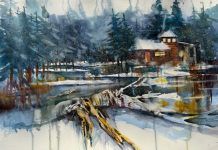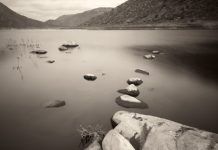More than a million seabirds and 100,000 marine mammals die ingesting plastic debris each year. Now, twice the size of continental America, the Pacific Ocean Gyre is a swirl of plastic dust that outnumbers naturally occurring plankton six to one. Not only is it affecting the life of the marine life, but also eventually makes it back to the consumer’s dinner table.
More than a million seabirds and 100,000 marine mammals die ingesting plastic debris each year. Now, twice the size of continental America, the Pacific Ocean Gyre is a swirl of plastic dust that outnumbers naturally occurring plankton six to one. Not only is it affecting the life of the marine life, but also eventually makes it back to the consumer’s dinner table.
Two East County artists, one specializing in fused glass, the other in silk painting have come together in creating a masterpiece of awareness, with plastic waste. Meet the Jelly Girls. Debb Solan, co-founder of Fusionglass Co. in La Mesa and Marjorie Pezzoli, silk painter extraordinaire and much more are now exhibiting “Jellies Forever,” at the Living Coast Discovery Center in Chula Vista through Labor Day.
As you walk into Living Coast, these colorful jellies float above, bringing awareness in the balance of the ocean life. Part of the food chain, whales and other sea creatures eat jellyfish at the polyp stage. When tiny jellyfish become planktonic, they become food for any sea creature, that filter feeds plankton. Sea turtle, ocean sunfish and blue rockfish are able to eat large jellyfish and many times seabirds and fish are able to evade the outer tentacles and get to the vulnerable inner tissue. Its biggest predator though is other jellyfish.
This project is a year in the making, recently installing “Jellies Forever” for the Museum of Monterey using plastic painter tarps, grocery bags and salvaged plastic wrap.
Solan said this team was already set when she decided to join it. A team of silk painters, one dropped out and she was approached to join the team, but only if she could do jellyfish. Originally, the thought was to create them in silk, but it seemed too large a project with the amount of dying and sewing it would take.
Pezzoli said this did not really work because it did not portray the problems the oceans face today.
“Literally sitting at my studio at 3:00 in the morning and we had been looking at green jellies all day,” said Solan. “Silk is not what is clogging up our oceans. We should be looking for a different material. And I looked up and saw a green roll of cling film a friend had given me for another project and those two thoughts that was it. Once I saw that I realized that was what we needed to do with this project.”
People think that plastic biodegrades, but it does not, it just moves around the ocean and gets smaller and smaller and the smaller it gets, the more sea creatures that feed on it, said Solan. “That is why we call it “Jellies Forever”
Solan said she received an email from Living Coast that talked about STEAM education with the arts involved and reaching out to local businesses
“I immediately responded because we had the jellies up in Monterey at the time and the exhibit was coming down in May so I asked if they would be willing to host the exhibit,” she said.
Solan received an immediate response with an “absolutely yes.” They began the yearlong preparations to bring the exhibit down from Monterey, an exhibit with the help of long-time friend and colleague Kira Corser as part of the Sea Act Project. This consists of teams of artists and scientist to bring collaborations between the arts and sciences and nurture the awareness in issues affecting the ecosystem in hopes of instigating research and positive change.
Pezzoli said she has been working with painting silk for more than 20 years, but in the end it is “playing with color” and technique was changed to create the same with plastics. She said it was not more difficult, but “just a different canvas” as silk absorbs and plastic does not. Using an airbrush for a fine layer and scrunching techniques with water-based colors were able to create the colorful exhibit. Solan said between themselves, and help from many friends and businesses they were able to accumulate the trash materials needed to complete the project.
Pezzoli said it you look closely you could see where much of the plastic came from as you can see store names on parts such as Wal-Mart, Ross and other stores on the jellies. In addition, the color of the plastics determined the colors used in creating the jellies.
Ben Vallejos, executive director of Living Coast Discover Center said as soon as you walk off the bus and walk through the doors of the Center the guest go “wow!”
“To me that is the most important. That first impression, even before they pay to come in sets the tone for their visit here,” he said. “I want the guest to be happy and I know they will be, but this takes it to a whole another level, different from the animals we have it is an artistic component made out of specialized recycled material. It tells our story and they can see the artists’ rendition of and see them live. So they can really correlate and it takes the learning of these animals to another level.”
Bringing arts and science together this partnership with the Living Coast Discovery Center and the Jelly Girls creates an exhibit is not only pleasing to the eye with the huge colorful jellies hovering above, but serves as a reminder of how fragile human’s interference with the ecosystems in the ocean are.
People can meet the Jelly Girls at Living Coast on Earth Day, April 18 as they teach a fun “Wish upon a Star” project and talk about the “Jellies Forever” installation. Solan and Pezzoli said this is a great ongoing relationship in the community. They are teaching staff at the Center other projects they created for helping the environment, such as creating sling handbags out of T-shirts that require no sewing at all.
For more information about the Jelly Girls and the environmental art they create visit www.thejellygirls.com and for hours and times for the Living Coast Discovery Center visit www.thelivingcoast.org.














